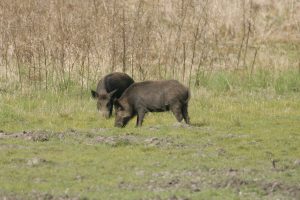 Wild, invasive pigs cause more than $90 million in damage to Louisiana farms each year and pose a growing threat to the environment, people and other animals. With $50K in support from the state, LSU is now moving into controlled field trials of a patent-pending bait based on fish, potatoes and, ironically, the key ingredient for bacon.
Wild, invasive pigs cause more than $90 million in damage to Louisiana farms each year and pose a growing threat to the environment, people and other animals. With $50K in support from the state, LSU is now moving into controlled field trials of a patent-pending bait based on fish, potatoes and, ironically, the key ingredient for bacon.
And while the LSU baits are effective on wild pigs, they have next-to-no impact on the environment, break down quickly and won’t harm animals or humans who might be tempted to eat the pigs.
“In Louisiana, with our growing seasons, there’s always something to eat,” said Glen Gentry, who is an animal scientist and director and coordinator of two LSU AgCenter research stations, including Idlewild, which specializes in wildlife management.
For close to a decade, Gentry has been working on solutions to the rapidly growing wild pig problem. People hunt and trap pigs, but not nearly enough to keep the population in check. A single sow can produce more than 400 descendants within three years, as her piglets reach maturity in six months and start having piglets of their own. This potential “pigdemic” is why Gentry partnered with LSU chemistry professor John Pojman to develop a solution. Together, they’ve come up with a patent-pending recipe for a bait that wild pigs love to eat (and prefer to corn, acorns and other favorites) but makes them fall asleep. It’s a chewy bait that’s golf-ball-sized. Ironically, the key ingredient is the same as for bacon—pink curing salt, or sodium nitrite.
“As a chemist, I’m quite proud that we’re able to simplify and solve a problem using general chemistry to help the citizens of the state,” Pojman said. “A great advantage of being a land-grant university is that we have both an agriculture college and a chemistry department with complementary expertise to tackle real and pressing problems.”
Luckily, pigs are much more sensitive to nitrites than humans are. Nitrites transform hemoglobin in the blood to methemoglobin, which reduces their body’s ability to get oxygen to cells. Pigs that eat bacon or consume just a few grams of sodium nitrite become starved for oxygen and fall asleep.
The researchers have already overcome significant hurdles. Gentry countered concerns about pets or other wild animals, including the protected Louisiana black bear, accidentally eating the baits by coming up with a selective delivery system using cameras and cell phones as remote triggers. A deer feeder can be loaded with corn—a favorite food of deer as well as pigs—and baits in separate compartments, so a farmer or other person can wait to release baits until they get visual confirmation that it’s wild pigs, not deer, at the feeder. When the Environmental Protection Agency had questions about potentially poisonous crumbs being left behind—pigs are voracious and messy eaters, after all—Gentry and Pojman staged another experiment. They added a fluorescent dye to the baits and checked for crumbs using a black light. They found no crumbs, partly because LSU’s fish-and-potato-based recipe gives the baits the consistency of gummy bears. Pojman’s team also solved the challenge of sodium nitrite accidentally breaking down into nitrate (with an ‘a,’ it smells like chlorine) by raising the pH using an antacid—“like putting Tums.” In a next step, they’ll tweak the chemistry a bit more so the baits change color when no longer effective, so farmers and others will know when to put in a fresh batch.
“LSU has come up with a unique and novel approach to reduce non-target exposure using cameras and remote triggers,” said Jim LaCour, state wildlife veterinarian for the Louisiana Department of Wildlife and Fisheries. “The only issue with the setup is that you might have to wake up at 3 a.m. to release baits and don’t always have a cell phone signal.”
To solve this, Gentry is now exploring an alternate delivery method, which we’ll call “the truffle approach.” Pigs can root for baits just as they root for truffles underground. Using either a bulb auger (a large drill that makes circular holes in the ground) or subsoiler pulled behind a tractor (“like pulling a knife through frosting on a cake”), farmers could drop and bury baits along the perimeter of their fields. Pigs, unlike almost every other animal, can smell and root up the baits to eat them, leading the pigs to fall asleep before they get a chance to do much damage. (However, this method can’t be used in areas where there are Louisiana black bears, Gentry is quick to point out. Bears would be able to dig up the baits.)
“It remains to be seen how effective each method will be in the wild,” Gentry said. “You see, pigs are smart and they learn. They’ll walk around a long-grain rice plot to eat medium-grain rice, and we’ve seen them prefer Roundup Ready corn to conventional corn with no genetic modifications. Not that they won’t eat it, but they’ll eat it last. The truth is that with pigs, you just never know quite what to expect.”



